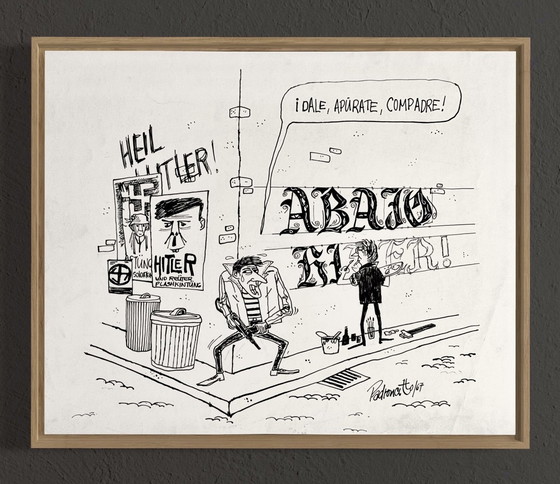Have it delivered hassle-freeBuyer protectionAll items curated by WhoppahDownload the Whoppah app here

Juan Padròn 1947-2020 Fantastic Cuban Political Drawing 1967, Renown Artist
Seller: Rosat Art€220€198-10%Offer from €135
Item not as advertised, money backAll items are curated and 100% authenticHave it delivered hassle-free or pick it up yourselfShop only from Trusted Sellers
Rosat Art
Product description
Artist: Juan Padròn alias Padroncitto 1947-2020 Cuba Work: political drawing in ink on paper Dimensions: 31cm high x 38cm wide Condition, good, small stains, a small old crease on the right-hand side Signature and date lower right Artist biography Juan Padrón is a Cuban cartoonist and illustrator renowned for his outstanding work and commitment to comics. Born in 1947 in Havana, Padrón has established himself as an emblematic figure in Cuban graphic art, thanks in particular to his creations that combine humor, social criticism and political reflection. His most famous character, Elpidio Valdés, is a young peasant hero who fights against colonial oppression and embodies Cuba's revolutionary values. Through Elpidio's adventures, Padrón tackles themes such as resistance, social justice and national identity. The character has become a symbol of Cuban culture, helping to spread revolutionary ideals throughout society. Juan Padrón's impact on Cuban politics is significant. His works, often broadcast on television and in the press, reinforced revolutionary propaganda while offering a subtle critique of social realities. Padrón used his art to educate and raise awareness of political and social issues, while preserving a playful and accessible approach. In addition to his work on Elpidio Valdés, Padrón has collaborated on various artistic and cultural projects, taking part in international exhibitions and receiving numerous awards. His influence extends beyond Cuba's borders, inspiring generations of artists and cartoonists around the world. Through his commitment and creativity, Juan Padrón remains a key figure in contemporary Cuban culture, testifying to the interaction between art, society and politics. Cuba's political context and the role of press cartoonists. In the 1960s, Cuba underwent a period of radical transformation, marked by the 1959 revolution that brought Fidel Castro to power. This period also saw the emergence of a rich and dynamic comic strip and illustration scene, particularly in the press. Cuban press cartoonists played a crucial role in narrating political and social events, but they also had to navigate a complex landscape, where freedom of expression was often tested by political pressure. Press cartoonists, such as Juan Padrón, used their art to comment on the rapid changes underway in the country, often with a mixture of humor and social criticism. Their works reflected revolutionary enthusiasm, but also the challenges Cuban society faced, such as censorship and state propaganda. Although the revolution promised a better life for the Cuban people, it also established a system where conformity to the regime's ideals was often demanded. Cartoons and comic strips became powerful tools, capable of reaching a wide audience while sometimes circumventing government restrictions. However, this freedom was precarious. Cartoonists had to juggle their desire to criticize the authorities with the need to conform to the regime's expectations. Artists who crossed the red lines of censorship risked reprisals ranging from publication bans to harsher penalties. The creation of cultural institutions and magazines specializing in comics, such as "Melao" and "Pionero", enabled many illustrators to express themselves, but often under the watchful eye of the state. The themes ranged from glorification of the revolution to more subtle reflections on the daily lives of Cubans. Despite the constraints, these artists found ways of expressing their ideas and capturing the spirit of a changing era. In short, Cuban press cartoonists of the 1960s were both witnesses and actors of their time. Their art, while influenced by political pressure, created a space for dialogue and reflection on Cuban reality. This period left a lasting imprint not only on Cuba's visual culture, but also on the way in which art can serve as resistance in the face of oppression.
Specifications
ConditionGoodColorsWhite, BlackMaterialPaperNumber of items1OrientationLandscapeArt sizeSmallHeight31 cmWidth38 cmSigns of usageStains, Discoloring













